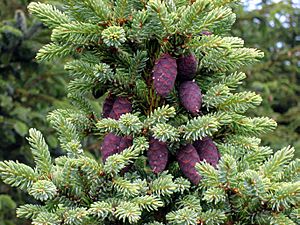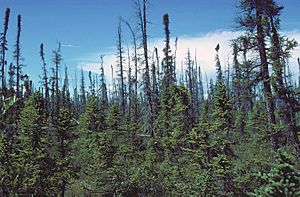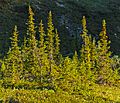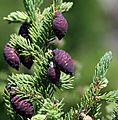Black spruce facts for kids
Quick facts for kids Black spruce |
|
|---|---|
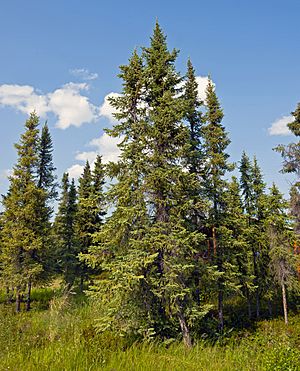 |
|
| Stand of black spruce near Inuvik, Northwest Territories, Canada | |
| Conservation status | |
| Scientific classification | |
| Genus: |
Picea
|
| Species: |
mariana
|
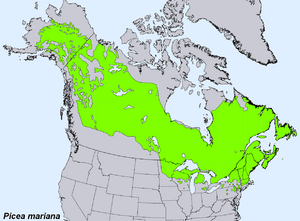 |
|
The black spruce (scientific name: Picea mariana) is a type of spruce tree. It belongs to the pine family. This tree grows all over North America. You can find it in every province and territory of Canada. It is the official tree of Newfoundland and Labrador. It is also the most common tree there. The black spruce also grows in northern parts of the United States. These areas include Alaska, the Great Lakes region, and the northeastern states. It is a common tree in the biome called the taiga or boreal forest. A biome is a large natural area with similar plants and animals. The Latin name mariana means "of the Virgin Mary."
Contents
What Does the Black Spruce Look Like?
The black spruce is an evergreen tree. This means it keeps its needles all year. It is a coniferous tree, which means it produces cones. It grows slowly and is usually small. It has a straight trunk that does not get much wider from bottom to top. Its branches often droop down but have tips that turn up.
Most black spruce trees are about 5–15 m (15–50 ft) tall. Their trunks can be 15–50 cm (6–20 in) wide when fully grown. Some trees can grow taller, up to 30 m (98 ft) high. Their trunks can reach 60 cm (24 in) across. The tree's bark is thin and scaly. It has a greyish-brown color.
Its leaves are like needles. They are 6–15 mm (1⁄4–9⁄16 in) long and stiff. Each needle has four sides. They are dark bluish-green on top. Underneath, they are a paler, glaucous green. Glaucous means they have a whitish, powdery coating.
The cones of the black spruce are the smallest of all spruce trees. They are 1.5–4 cm (1⁄2–1+1⁄2 in) long. They are also 1–2 cm (1⁄2–3⁄4 in) wide. The cones are shaped like a spindle or are almost round. They start dark purple and turn reddish-brown when ripe. They grow in tight groups at the top of the tree. They open when ready but stay on the tree for several years.
How Black Spruce is Different
The black spruce can sometimes mix with other spruce types. This is called hybridization. It often mixes with the red spruce (Picea rubens). It rarely mixes with the white spruce (Picea glauca).
You can tell the black spruce apart from the white spruce. Young branches of the black spruce have tiny hairs. Its bark is often a darker reddish-brown. Its needles are shorter. Its cones are smaller and rounder. It also prefers wetter, low-lying areas.
It is different from true fir trees, like the balsam fir (Abies balsamea). Black spruce cones hang downwards. Its needles are four-sided and grow all around the branches. Fir trees have cones that stand upright.
Where Black Spruce Lives and Grows
The way black spruce grows depends on the quality of its home. In wet areas like swamps and muskegs (spongy bogs), it grows slower in the middle. Its roots are shallow and spread out wide. This makes it easy for strong winds to blow the tree over. This is called windthrow.
In northern areas, you might see "ice-pruned" trees. These trees have fewer needles on the side facing the wind. Sometimes, trees lean over, looking like "drunken trees". This happens when the ground they grow in, called permafrost, thaws.
In the southern parts of its range, it mostly grows in wet, rich soils. Farther north, it grows more on higher, drier lands. In the Great Lakes region, it is common in peat bogs and swamps. It also grows in areas between wet peatlands and dry uplands.
Many black spruce forests have trees that are all about the same age. This is because forest fires happen often. The black spruce often grows alone in wet, rich soils. It can also grow with other trees in mineral soils. It can live in soils that do not have many nutrients. It is often found in wet, acidic peatlands.
Black spruce is a pioneer species. This means it is one of the first plants to grow in new or disturbed areas. It can grow in sphagnum moss mats in bogs. It often grows after another tree called tamarack (Larix laricina). Black spruce can often out-compete tamarack. This means it grows better and takes over.
Over time, as the soil in bogs gets richer, other trees might replace the black spruce. These include balsam fir and northern white cedar (Thuja occidentalis). After fires, black spruce can also take over areas where jack pine (Pinus banksiana) grew. This is because black spruce can grow in partial shade. However, young black spruce trees do not grow well in low light or dry conditions under older spruce trees.
Pests and Challenges
The spruce budworm is a type of moth larva. It eats the needles of spruce trees. If this happens for several years, it can kill the trees. Black spruce is less likely to be harmed than white spruce or balsam fir. Trees growing near balsam fir and white spruce are most at risk.
Growing Black Spruce in Gardens
Many special types of black spruce, called cultivars, have been chosen. People grow them in parks and gardens. One dwarf type, P. mariana 'Nana', has won an award. This is the Royal Horticultural Society's Award of Garden Merit. Black spruce can also mix with other spruce trees. It can hybridize with Serbian spruce (Picea omorika). This creates a hybrid called Picea machala. It can also hybridize with Sitka spruce.
Uses and Symbolism
The black spruce is the official provincial tree of Newfoundland and Labrador. The wood from these trees is not usually very valuable because the trees are small. However, it is a very important source of pulpwood. Pulpwood is wood used to make paper. It is the main source of pulpwood in Canada.
Many fast-food chopsticks are made from black spruce. Companies like Nordic Structures are also using it to make cross laminated timber. This is a strong building material. The tight growth rings of the black spruce make it very strong. People have also used black spruce, along with red spruce, to make spruce gum and spruce beer.
Images for kids
-
Boggy taiga habitat
See also
 In Spanish: Pícea negra para niños
In Spanish: Pícea negra para niños



